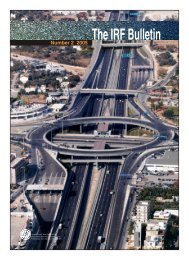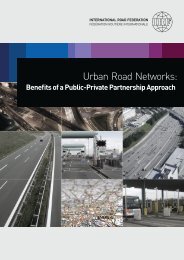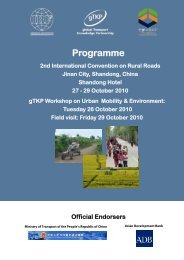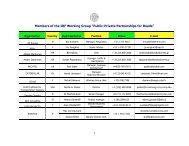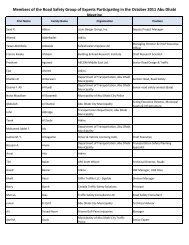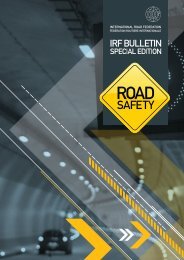TRANSPORT
TRANSPORT
TRANSPORT
- No tags were found...
You also want an ePaper? Increase the reach of your titles
YUMPU automatically turns print PDFs into web optimized ePapers that Google loves.
MANAGEMENT<br />
Implementation<br />
Considerable emphasis is placed on community/beneficiary<br />
participation in infrastructure planning, implementation<br />
and maintenance. Development planners increasingly<br />
acknowledge the importance of this dimension for<br />
maximising the impact of rural infrastructure. Infrastructure<br />
that does not represent the hopes and aspirations of the<br />
community will not tend to be fully adopted or used by<br />
the local people. As a consequence, the community will be<br />
reluctant to share responsibility for its maintenance.<br />
There is also firm emphasis on labour-based technology, i.e.<br />
the use and management of locally available human and<br />
material resources for the construction and maintenance<br />
of infrastructure. One of the key advantages of this is that<br />
local people are employed and trained in construction work<br />
and maintenance, thereby developing their vocational<br />
skills. In this respect, the objectives are: (a) to engage the<br />
workforce directly in a labour intensive area, (b) reduce<br />
poverty, (c) minimise costs and (d) reduce the time span for<br />
construction (as work can proceed directly, using readily<br />
available labour and light equipment). All operations can be<br />
efficiently undertaken in this manner, including earthworks,<br />
haulage, placing, levelling, aggregate breaking, mixing,<br />
placing, connecting, and so on.<br />
Construction work on approved schemes generally involves<br />
the following modes of implementation: Contractor; Project<br />
Implementation Committee (PIC); and Labour Contracting<br />
Society (LCS).<br />
From a governance standpoint, key features covering<br />
the various project phases typically include: planning;<br />
participation; road master plans; financing; procurement;<br />
quality control; environmental considerations; financial<br />
management; auditing and monitoring; institutional<br />
strengthening/capacity building; Information and<br />
Communications Technologies / Geographical Information<br />
Systems / Management Information Systems (undertaken<br />
within LGED); employment generation; gender<br />
mainstreaming; and socio-economic monitoring and<br />
evaluation.<br />
Local people and road users can also have an important<br />
role to play in raising awareness, demonstrating the<br />
importance of road improvement/maintenance policies,<br />
enforcing the regulatory framework, strengthening<br />
accountability and participating in road management.<br />
To be effective, however, they need to be organised into<br />
road user associations, and should be encouraged to work<br />
closely with both road agencies and the Government.<br />
The ongoing maintenance of roads and bridges/culverts is<br />
being given increasing importance as a project component,<br />
and this dimension is ensured through allocations from the<br />
Revenue Budget of the Government of Bangladesh (GOB).<br />
Maintenance activities are classified as routine, periodic,<br />
emergency, or for the purposes of rehabilitation or covering<br />
backlog.<br />
NGOs are actively engaged in various LGED infrastructure<br />
projects – initiating and executing community development<br />
24<br />
| IRF BULLETIN SPECIAL EDITION: RURAL <strong>TRANSPORT</strong>, VOLUME-2



